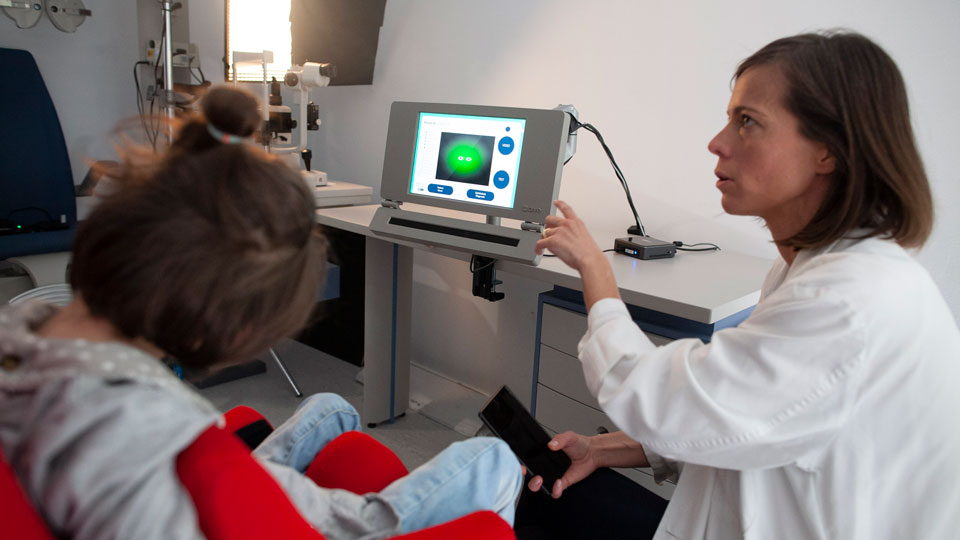- OT
- Science and vision
- Technology
- Tracking children’s vision needs
Key milestones
Tracking children’s vision needs
Paediatric ophthalmologist at DIVE Medical, Victoria Pueyo, shares insight into Track AI, a project designed to develop technology that can identify visual problems in children earlier

Victoria Pueyo
22 June 2019
01 About 19 million children worldwide are visually impaired and 1.4 million of them are completely blind. Yet 70–80% of these cases could have been treated or cured if they had been detected earlier.
Therefore, we need a reliable, portable and easy-to-use way of identifying children with visual problems early. That is why, for the past few years, we have been committed to developing a Devices for an Integral Visual Examination (DIVE) tool that assesses the visual function in young children and helps identify those with visual impairments. This multidisciplinary research has turned into the startup DIVE Medical.
We are now working on Track AI, a project in partnership with DIVE Medical, IIS Aragon and Huawei. Through it we aim to develop a system that works without the need of an experienced examiner to identify children with visual problems who need to be referred to an expert for diagnosis and treatment.
We hope to bring this technology to every corner in the world so that there less children with undiagnosed visual problems
02 Through the Track AI partnership, we are now extending DIVE on a world scale and multi-ethnic approach, with the objective of detecting specific visual impairments in any child.
The Track AI system, composed of a DIVE device and a P30 smartphone, is designed to examine several aspects of visual performance that cannot be assessed by traditional examinations, especially when a patient is young. By means of the implementation of artificial intelligence (AI) algorithms, this system can be used as a very accurate tool for visual screening programs in childhood. Its easy-to-use interface and automated examination process, allows any person without specific training to use it and get information on whether a child has normal visual development, or if they may suffer from a specific visual pathology. Children whose results point to visual pathologies can be redirected to a clinician for a complete diagnosis and treatment. This is especially useful in underdeveloped countries and areas where access to qualified examiners is scarce.
The Track AI system is currently in development. In order to build a system based on AI, we have to gather data from thousands of children. This data is currently being collected using the DIVE device in five countries across three continents.

03 Late identification of a visual disorder in a child has deep consequences on their vision, general development, social life and academic achievements.
With DIVE and the Track AI system, we aim to take visual screening for children from only a few months of age to every corner in the world, without the need of highly experienced examiners. This will enable early detection of visual problems in any country and help bring medical care to those children who need it, greatly improving their opportunities.
04 In the next 12 months we will finish developing the first prototype of the Track AI system, which involves collecting data from thousands of children, designing and training the AI algorithms, and building a standalone system composed of a DIVE device and a P30 smartphone.
This system, after extensive validation, will allow non-experienced examiners to evaluate the vision of children from six months of age and obtain a probability for if the patient has a certain specific pathology. This will help non-professionals, such as parents, to catch their children’s visual problems early, and enable practitioners to make a more timely diagnosis and better decisions about treatment.
Every child has the right to healthcare, and AI is turning smartphones and other devices into powerful diagnostic tools that make it possible to
05 In the next five years, we hope to bring this technology to every corner in the world so that there are less children with undiagnosed visual problems.
We will also continue improving the DIVE device and the Track AI system, implementing tests to assess more aspects of visual function, adding the detection of more visual pathologies and making it more portable. Every child has the right to healthcare and AI is turning smartphones and other devices into powerful diagnostic tools that make access possible. Thousands of children may benefit from this technology in the following years as these new capabilities become available for the first time.
Advertisement

Comments (0)
You must be logged in to join the discussion. Log in